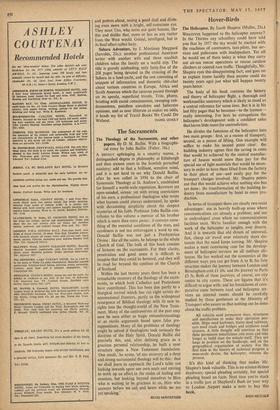Hover-Birds
The Helicopter. By Jacob Shapiro. (Muller, 21s.) WHATEVER happened to the helicopter anyway?- In the Thirties any schoolboy could have told you that by 1957 the sky would be stacked with the machines of commuters, taxi-pilots, bus ser-
vices and policemen with loudspeakers. Yet all he would see of them today is when they carry out air-sea rescue operations or rescue careless climbers or control race traffic. Thoughtfully, Mr. Shapiro eyes this disappointing fact; and goes on to explain (more lucidly than anyone could do twenty years ago) just what will happen twenty years hence.
The body of his book contains the history and theory of helicopter flight, a thorough and workmanlike summary which is likely to stand as a central reference for some time. But it is in his last fifty pages that he becomes—to the layman— really interesting. For here he extrapolates the helicopter's development with a confident calm that leaves little room for contradiction.
He divides the functions of the helicopter into two main groups : first, as a means of transport; second, as a means of lifting. One example will suffice to make his second point • clear : the building industry agrees that the saving in costs that would be achieved by the central manufac- ture of houses would more than pay for the special use of light materials that would be neces- sary in order to have them lifted from the factory to their place of use—and easily pay for the transport charges involved. Mr. Shapiro points out that this would achieve what nothing else has yet done : the transformation of the building in- dustry from manufacture by hand to mass pro- duction.
In terms of transport there are clearly two main advantages: use in heavily built-up areas where communications are already a problem; and use in undeveloped areas where no communications facilities exist. We're familiar enough with the work of the helicopter in jungles, over deserts. And it is towards that old dreatti of universal, fast, cheap air travel over relatively short dis- tances that the mind keeps turning. Mr. Shapiro makes a most convincing case for the develop- ment of helicopter services on all medium dis- tances. He has worked out the economics of the different ways you can get from A to B; his fare structure makes the journey between London and Birmingham cost £1 10s. and the journey to Paris £3 3s. Both of these journeys, of course, are city centre to city centre. These are figures that it's difficult to argue with; and his breakdown of com- parative costs between road and helicopter ser- vices on internal routes should be carefully studied by those gentlemen at the Ministry of Transport who assure us that nothing can be done about the traffic problem.
All vehicles need permanent ways, structures and installations to make their operation pos- sible. Ships need harbOurs, trains need railways, cars need roads and bridges and airplanes need airports. A little thought will convince us that these permanent installations cost more and take longer to build than the vehicle itself. They are large in position on the landscape, and on the geographical organisation of society. For the first time in the history of technical progress a man-made device, the helicopter, reverses the process.
It's this kind of thinking that makes Mr. Shapiro's book valuable. This is no science-fiction daydream; special pleading certainly, but special pleading based on facts. Next time you're stuck in a traffic jam at Shepherd's Bush on your way to London Airport make a note to buy this book.
JOIN METCALF


































 Previous page
Previous page